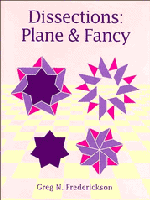Book contents
- Frontmatter
- Contents
- Preface
- 1 “Dat Pussle”
- 2 Our Geometric Universe
- 3 Fearful Symmetry
- 4 It's Hip to Be a Square
- 5 Triangles and Friends
- 6 All Polygons Created Equal
- 7 First Steps
- 8 Step Right Up!
- 9 Watch Your Step!
- 10 Just Tessellating
- 11 Plain Out-Stripped
- 12 Strips Teased
- 13 Tessellations Completed
- 14 Maltese Crosses
- 15 Curves Ahead
- 16 Stardom
- 17 Farewell, My Lindgren
- 18 The New Breed
- 19 When Polygons Aren't Regular
- 20 On to Solids
- 21 Cubes Rationalized
- 22 Prisms Reformed
- 23 Cheated, Bamboozled, and Hornswoggled
- 24 Solutions to All Our Problems
- Afterword
- Bibliography
- Index of Dissections
- General Index
13 - Tessellations Completed
Published online by Cambridge University Press: 05 August 2012
- Frontmatter
- Contents
- Preface
- 1 “Dat Pussle”
- 2 Our Geometric Universe
- 3 Fearful Symmetry
- 4 It's Hip to Be a Square
- 5 Triangles and Friends
- 6 All Polygons Created Equal
- 7 First Steps
- 8 Step Right Up!
- 9 Watch Your Step!
- 10 Just Tessellating
- 11 Plain Out-Stripped
- 12 Strips Teased
- 13 Tessellations Completed
- 14 Maltese Crosses
- 15 Curves Ahead
- 16 Stardom
- 17 Farewell, My Lindgren
- 18 The New Breed
- 19 When Polygons Aren't Regular
- 20 On to Solids
- 21 Cubes Rationalized
- 22 Prisms Reformed
- 23 Cheated, Bamboozled, and Hornswoggled
- 24 Solutions to All Our Problems
- Afterword
- Bibliography
- Index of Dissections
- General Index
Summary
For many, it was a highlight of the month when The Strand Magazine appeared. Besides articles of general interest and the short stories by such notables as C. K. Chesterton, P. C. Wodehouse, and A. Conan Doyle, there was “Perplexities,” the all-too-aptly-titled column of mathematical puzzles by that clever chap Henry E. Dudeney. In the May 1926 issue, Dudeney had solved a difficult puzzle, that of cutting a regular octagon into a square in only seven pieces. Then, in September, he concluded his column with the following unexpected comment:
“As I have often remarked, concerning these Cuttingout puzzles, there is generally no way of determining positively that you have discovered the most economic solution possible. The solution to this puzzle, in seven pieces, that I gave in our May issue, was the best then known, but the record has been beaten, for I have received from Dr. C T. Bennett this very simple and elegant solution in as few as five pieces. I do not think that this can possibly be beaten.”
Geoffrey Bennett's dissection, from (Dudeney, Strand, 1926d), is shown in Figure 13.2. It is one of the most beautiful in the field. As the excerpt establishes, the dissection is also a notable example in which the master puzzlist Henry Dudeney was bettered. Dudeney's 7-piece dissection, in (Dudeney, Strand, 1926b), transformed the octagon into a rectangle in four pieces and then converted the rectangle to a square with a P-slide, introducing three more pieces. But Bennett's was a new type of dissection, using a novel technique that Harry Lindgren has called completing the tessellation.
- Type
- Chapter
- Information
- DissectionsPlane and Fancy, pp. 150 - 156Publisher: Cambridge University PressPrint publication year: 1997



